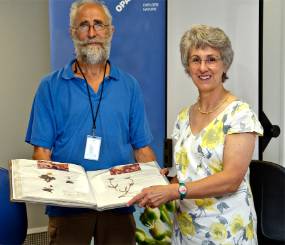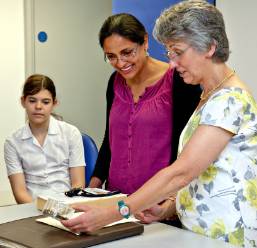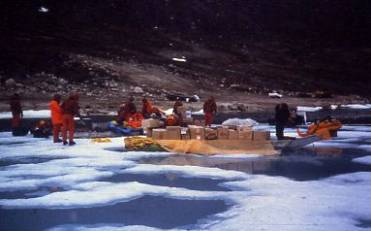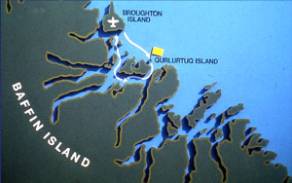Last week we honoured Captain Scott's heroic three-man team who on 27 June 1911 set off on one of the worst Antarctic journeys ever known to find Emperor penguin eggs in Cape Crozier.
Coincidentally, it was also the week we remembered some much younger Arctic explorers and their school teacher Philippa Wood. This courageous team were marooned on the Canadian Arctic's tiny Qurlatuq Island in 1978 while collecting plants, crustaceans and butterfly specimens for a scientific youth project. Before the trip, the team were trained by some of our scientists at the Museum.
Science teacher Pip Wood (right) presents Museum scientists Roy Vickery and Blanca Huertas with Arctic plant and butterfly specimens collected on a school expedition in 1978 that we helped to train up.
Pip (Philippa) now teaches at a girls school in Reigate and she visited the Museum last week with thirty of her pupils to donate the plant and butterfly specimens she collected on the original 1978 Arctic expedition. She told us:
'The plants and other artefacts such as mounted seal flipper bones, a caribou hoof, a snowy owl pellet, and polar bear poo (full of bear fur from either preening or possibly a cub meal for an adult male) have been visual teaching aids over the years.
'I intend to retire in July 2012, and as my present school, Dunnotar Girls School in Reigate, is such a lovely place to work, I hoped a donation could somehow involve the girls and be used as a source of inspiration. Every teacher can only hope to provide an experience which may lead who knows where in later years for the students.'
The original Arctic school trip known as BYEX 78 - Baffin Island Youth Expedition of 1978 - took place in the summer months of that year and lasted six weeks.
The BYEX 7-strong team of 16-19-year-old boys and girls from three Surrey state schools were the first team of youngsters that included girls to climb to the height they reached in the Arctic. In fact, it was the first-ever state school trip. They were accompanied by four adults including Pip who was responsible for collecting plants on the trip.
Their exploration was full of dramatic, ice-cracking adventures! The expedition was even featured in a BBC programme about young explorers.
Pip recalls the scientific challenges on the expedition (pictured right and below):
'We were on Baffin Island in Arctic Canada, but the majority of specimens we collected were from a one-mile-square island, called Qurlatuq, southeast of Broughton Island, where we were marooned for two weeks as the sea wasn't passable by either sledge or boat!
'We managed to do a line transect across the top of the island (about 200m) using surveying and climbing skills, data collection (pH, salinity, aspect, altitude, etc) and identification skills.'
When the 1978 expedition group returned home, the crustacean specimens collected were handed over to our Museum. But Pip hung on to the plant and butterfly specimens as more time was needed to verify and label them. They then became teaching aids. And now they have arrived here 33 years later.
Among the scientists who trained Pip and her team before they headed out on their original expedition was Museum botanist Roy Vickery (above left with Pip). Roy has now retired but still works at the Museum as a Scientific Associate.
Both Roy and our butterfly curator, Blanca Huertas, were present at the handover of Pip's specimens last week. Roy says:
'When we gave advice about how to collect to school and university expeditions like this one, it was usual for them to donate their collections soon after the completion of their expeditions, but it was often far more difficult to obtain the label data for them. So it's good, after all these years, to receive Pip's specimens, which have been beautifully prepared and fully labelled.
'At a time when climate change threatens the Arctic flora, it's great to have Pip's specimens as a record of what was growing in her expedition's area 33 years ago.'
The 36 plant specimens donated include an Arctic poppy, rose, sunflower, evening primrose, bluebell, mustard and willow, as well as one fern family. Of the beautiful butterflies, 'one is a 'yellow' and four are fritillaries,' says Pip. They are now being examined and identified by our scientists.








